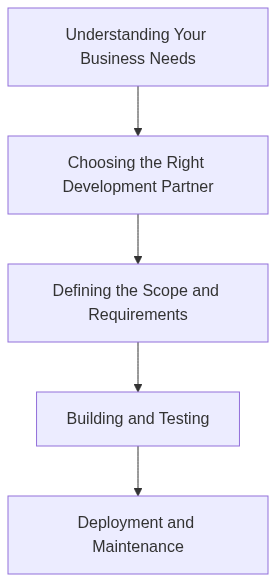Custom software development can be a complex process, but understanding the five main stages can help ensure the success of your project. In this article, we will delve into the details of each stage and provide valuable insights to help guide your project from start to finish.
Stage 1: Planning and Requirements Gathering
The first stage of custom software development is all about understanding the needs of the client. This includes gathering information about the project, including the scope, budget, and timeline. It's important to clearly define the goals and objectives of the project at this stage, as well as identify any potential roadblocks or challenges that may arise.

During this stage, it's also important to identify the key stakeholders involved in the project, including the client, project manager, and development team. This will help ensure that everyone is on the same page and that the project stays on track.
Stage 2: Design and Architecture
Once the planning and requirements gathering stage is complete, the next step is to design and architect the software. This includes creating detailed specifications and blueprints for the software, as well as determining the best technology stack to use.
During this stage, it's important to take into account the scalability, maintainability, and security of the software, as well as the user experience. It's also important to test the design and architecture to ensure that it meets the requirements defined in the planning stage.
Stage 3: Development and Implementation
Once the design and architecture are complete, the next step is to begin development and implementation of the software. This includes coding, testing, and debugging the software.
Flowchart of Development and Implementation
During this stage, it's important to use agile development methodologies and to continuously test and deploy the software to ensure that it meets the specifications defined in the previous stages. It's also important to keep the client informed of the progress and to address any issues or concerns that may arise.
Stage 4: Testing and Quality Assurance
After the software has been developed and implemented, the next step is to thoroughly test and quality assurance. This includes conducting various types of testing, such as unit testing, integration testing, and acceptance testing, to ensure that the software meets the requirements defined in the planning stage.
During this stage, it's important to identify and address any bugs or issues that may arise and to ensure that the software meets the standards of quality.
Stage 5: Deployment and Maintenance
The final stage of custom software development is deployment and maintenance. This includes installing and configuring the software, as well as providing ongoing support and maintenance to ensure that the software continues to function as intended.
During this stage, it's important to provide training and documentation to the client, as well as to monitor the performance of the software and address any issues that may arise. This includes conducting regular updates, backups, and security checks to ensure that the software remains secure and up-to-date.
It is also important to have a plan in place for handling any potential issues or bugs that may arise in the future. This includes having a dedicated team in place for providing ongoing support and maintenance.
Conclusion
In conclusion, custom software development is a complex process that involves multiple stages. Understanding the five main stages of planning and requirements gathering, design and architecture, development and implementation, testing and quality assurance, and deployment and maintenance, can help ensure the success of your project. By focusing on the details of each stage, you can help guide your project from start to finish, and deliver a high-quality software solution that meets the needs of your client.
